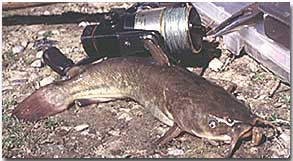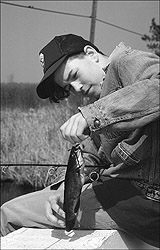Spring Bullheads
Spring Bullheads
 The angler's urge is never stronger than in spring. Even among many who fish but once a year, spring is the chosen time. They're drawn on an ancestral pilgrimage to rivers to watch the ice recede, to soak in the warm glow of nature's renewal, and to feel the tug on a line that makes them part of it all. Lakes are nice, but rivers cast the broadest spell in early spring, entrancing people with action and rekindling spirits. A stately parade of ice floes heaving and shifting in the current makes it feel like something beneath is trying to break out. Lakes let spring happen to them as the ice slowly evaporates. Rivers disgorge winter in a rising, surly flow, which reaches into meadows and woodlands to drive the stale coldness from the darkest pockets. As the water recedes, a bursting chorus of life blooms in shallow, warming bays and backwaters. The river has set the stage for nature's regeneration.
Brown bullheads are one of the first fish to be drawn into the shallows to feast on a rich supply of insects and minnows. After a long winter slowdown, the females feed voraciously to replenish energy and build egg masses in preparation for spawning. They won't, however, spawn until the water settles and reaches 70 F (21 C). A big appetite, a tough attitude on a line, and delightful table qualities have made the unpretentious bullhead the epicentre of spring fishing tradition in eastern Ontario. The angler's urge is never stronger than in spring. Even among many who fish but once a year, spring is the chosen time. They're drawn on an ancestral pilgrimage to rivers to watch the ice recede, to soak in the warm glow of nature's renewal, and to feel the tug on a line that makes them part of it all. Lakes are nice, but rivers cast the broadest spell in early spring, entrancing people with action and rekindling spirits. A stately parade of ice floes heaving and shifting in the current makes it feel like something beneath is trying to break out. Lakes let spring happen to them as the ice slowly evaporates. Rivers disgorge winter in a rising, surly flow, which reaches into meadows and woodlands to drive the stale coldness from the darkest pockets. As the water recedes, a bursting chorus of life blooms in shallow, warming bays and backwaters. The river has set the stage for nature's regeneration.
Brown bullheads are one of the first fish to be drawn into the shallows to feast on a rich supply of insects and minnows. After a long winter slowdown, the females feed voraciously to replenish energy and build egg masses in preparation for spawning. They won't, however, spawn until the water settles and reaches 70 F (21 C). A big appetite, a tough attitude on a line, and delightful table qualities have made the unpretentious bullhead the epicentre of spring fishing tradition in eastern Ontario.
Tradition has a lot to do with simplicity. Traditions arise for a lot of good reasons, but the most enjoyable is not having to think about why you are doing it; you just let it happen. Tradition and ritual take the complexity out of life, boiling things down to the basics - and there's nothing more basic than spring on a river and bullheads. They seem made for the simple, sweet art of angling. All you need is a hook, line, and sinker. A rod is optional. The sinker is optional too, if you have an old sparkplug, but don't forget worms.
The no-fuss, no-clutter approach to bullheading allows an angler to concentrate on important stuff, like blackbirds protesting from cattails, finding wood for a fire, and lighting a lantern as the sun sets. Finessing bullheads with light lines, small hooks, and lure colour changes brings unneeded anxieties of modern angling to the fore. Better to leave that stuff and that attitude at home. Any medium-weight rod with 8- to 12-pound-test line, a couple of nightcrawler-baited No. 4 to 6 long-shanked snelled hooks tied 6 and 18 inches above a 3/4-ounce bell sinker are all the equipment you need. I like a fat bobber to indicate a bite or one of those little bells that clip onto a rod tip for detecting bites in the darkness. A folding lawnchair with armrests is de rigueur, as is a bucket for your catch. Finally, bring a knife to cut a forked stick to prop up your rod on the riverbank; anchor the rod butt with a stone. Nothing else will do.
 More than any other factor, location can add to the fish-catching success of a bullhead expedition. Bullheads like any warm, shallow water over a muddy bottom, but they concentrate where food is especially abundant. They also avoid clear shallow water, where they're vulnerable to predators during daylight. The usual situation is three to four feet (about 1.2 m) deep, out 20 to 30 feet (6 to 9 m) from shore. Try different depths, placing your bait in several locations, and moving along the shore.
More than any other factor, location can add to the fish-catching success of a bullhead expedition. Bullheads like any warm, shallow water over a muddy bottom, but they concentrate where food is especially abundant. They also avoid clear shallow water, where they're vulnerable to predators during daylight. The usual situation is three to four feet (about 1.2 m) deep, out 20 to 30 feet (6 to 9 m) from shore. Try different depths, placing your bait in several locations, and moving along the shore.
Slow going during the day can turn into fast action in the evening. Make your stand then where you caught at least one fish during the day, because it's not unusual for the whole gang to show up after dark. The nice thing about bullheads is that they'll follow the smell of your bait and come to you when they're active. Patience is a virtue at dusk.
Early in the season, ice recedes gradually from shallow water toward the centre of a backwater. The melt pattern is a clear indication of how water warms around shore and extends out. Great bullhead catches can be taken in open shoreline water, even while the remainder of a bay is covered in ice. The mouths of slow-moving creeks are favourites with bullhead anglers because the warmer inflows attract forage that brings in the little catfish. Anchored in the mouth of a creek or channel, with the lantern glowing, is a great way to celebrate spring on a river.
Catching fish is only part of the bullheading tradition. Spring is a time for nature's renewal and a chance to rediscover our own links to the natural world. Humans evolved as social animals, a fact sometimes difficult to believe in our modern society, where we seldom know even our closest neighbour. A roaring fire on a riverbank brings us back to earlier times when we depended upon the people around us to survive and to flourish. Fire, water, and bullheads are basic elements that break down social barriers and have you conversing with a perfect stranger like a life-long friend. Kids also rally to this combination. They love poking the fire, reeling in fish, and bringing all kinds of young visitors into the ring. It might be one of the only times kids get to talk to and learn from strangers.
Spring bullheading can take the world back to where it once was or, some might say, to where it ought to be. It's a big step for a simple tradition, but such is the spell of spring on a river. When I ask anglers what draws them to rivers each spring to catch bullheads, they give me a "if-you-had-to-ask-the-question, you-couldn't-possibly-understand-the-answer" look. I guess that's the beauty of bullheads, rivers, and spring traditions.
This article is written with permission by Fish Ontario. Visit their website, http://www.fishontario.com, for more Ontario fishing information.
Fish Ontario
|
